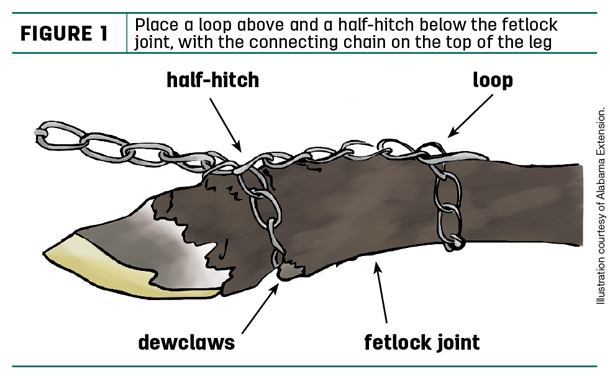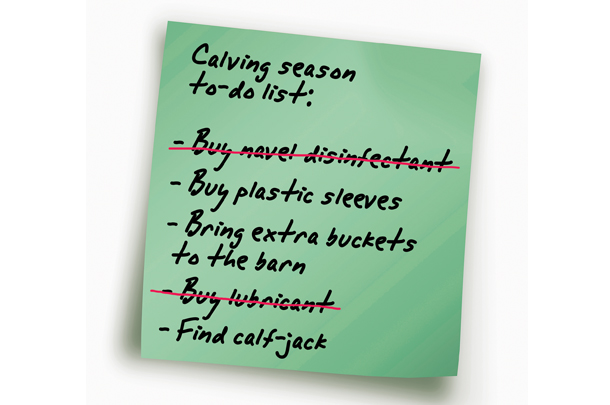Cows should be checked at least daily during the calving season, and heifers should be checked more frequently, perhaps several times a day. Having cows and heifers in an easily accessible pasture will make this task more manageable. Also, allowing animals to calve in clean pastures is better for the health of the calf and the cow or heifer.
One of the complications possibly encountered during the calving season is dystocia (a difficult delivery), and sometimes calving assistance is required.
Therefore, it is important to be familiar with the signs of impending parturition (calving) as well as the sequence and timing of events associated with normal labor and delivery to help determine when assistance is necessary.
Signs of impending parturition
- The udder and vulva will often enlarge one to three weeks prior to calving.
- Cows and heifers often become more nervous or act restless and, if possible, may isolate themselves from the rest of the herd just prior to calving.
- Cows and heifers may show signs of abdominal discomfort by kicking at their belly; they may also glance to the rear nervously.
- The tailhead appears raised as ligaments around the rump of the cow or heifer relax.
Normal parturition is divided into three sequential stages
Stage 1 – Preparatory
- Duration – cows (four to eight hours); heifers (six to 12 hours)
- The cow or heifer may become nervous and isolate herself from the rest of the herd.
- Uterine contractions begin.
- “Dropping” of colostrum/milk into the teats.
- “Water bag” appears toward the end of this stage. Stage 2 begins when the water bag breaks.
Stage 2 – Delivery of the calf
- Duration – cows (less than one hour); heifers (one to four hours)
- The cow or heifer is now actively straining.
- During normal parturition, the calf’s forelegs and head protrude first about 70 percent of the time, and the hind legs and tail come first about 30 percent of the time.
- The calf is delivered.
Stage 3 – Expulsion of the placenta (afterbirth)
- Duration – cows and heifers (one to 12 hours, usually occurs within the first few hours)
- Cow or heifer straining decreases.
- Uterine contractions continue, and the placenta is expelled.
- If the placenta is not expelled soon after birth, do not manually remove the placenta by pulling it out. Contact your veterinarian instead.
Assistance may be necessary when calving does not proceed as described, and early intervention is the key to a successful outcome. Waiting too long to provide assistance unnecessarily risks the health or life of the cow or heifer and her calf.
Seek the help of a veterinarian or experienced cattle producer when needed.
Supplies used to assist with calf delivery
- Obstetrical (OB) chains or ropes. Chains are preferred because they can be easily disinfected after use. OB chains and ropes are used for pulling on a calf’s legs only. (See Figure 1 for proper placement of OB chains.)

- OB handles for pulling on OB chains
- Mechanical calf puller (“calf-jack”)
- OB lubricants
- Plastic OB sleeves
- Water buckets for cleaning and disinfection
- Towels and paper towels
- Disinfectant for the calf’s navel
Practices to avoid when delivering a calf
- Never attach OB chains or ropes to a calf’s jaw because the jaw will almost always fracture.
- Do not apply excessive force when using a calf-jack. A calf-jack is a very useful tool, but it can exert substantial force on the cow or heifer and the calf. If used improperly, the cow, heifer or calf can be injured or killed, so use with caution.
- Never attempt to deliver a calf by pulling with any type of vehicle.
Some things to keep in mind
- Calving takes time, and it often takes longer for heifers than cows, so be patient. However, progress should be steady and generally fit within the time frames previously mentioned. Once Stage 2 begins (delivery of the calf), the cow or heifer should make visible progress about every 15 to 20 minutes.
- Use the “two plus one rule” to help determine when to call for help. Upon visual or vaginal examination, two feet and one head (or two feet and one tail) should be seen or felt for a normal delivery to proceed. If adequate time has elapsed, and “two plus one” is still not seen or felt, then assistance is needed.
- If the cow or heifer becomes exhausted and quits trying to calve, then assistance is necessary.
- When in doubt, call your veterinarian. The outcome is always more favorable if assistance is provided sooner rather than later.
- No more than two strong people should pull on a calf at the same time.
 If possible – and if safe for you and the animal – corral the cow or heifer needing assistance before your veterinarian arrives. This will make your veterinarian’s job easier and minimize your expenses.
If possible – and if safe for you and the animal – corral the cow or heifer needing assistance before your veterinarian arrives. This will make your veterinarian’s job easier and minimize your expenses. ![]()
Soren Rodning is an associate professor and extension veterinarian at Auburn University. Email Soren Rodning.







